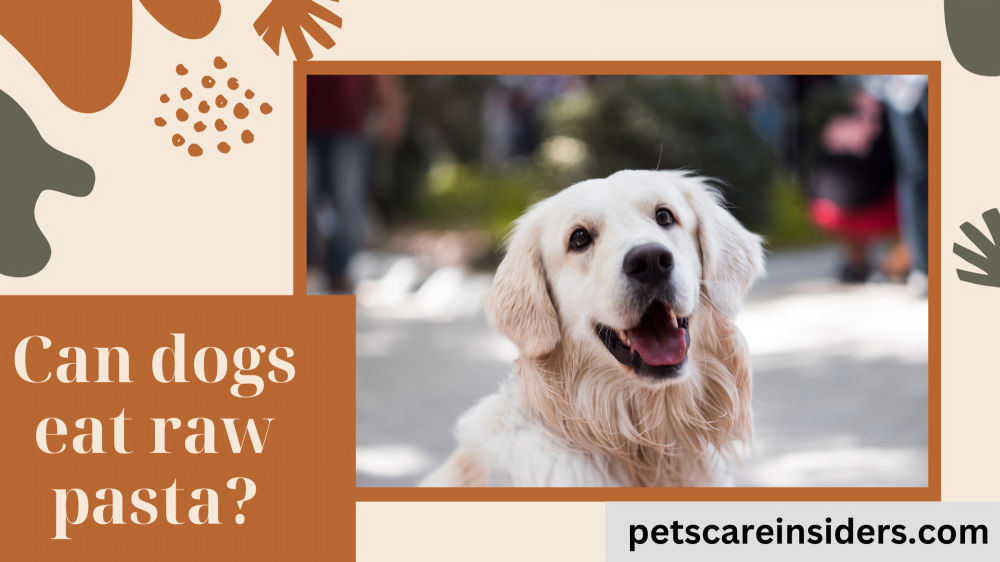As pet owners, we often share a common concern about the safety of various human foods for our furry companions. One such food that raises questions is raw pasta, a staple in many households. While cooked pasta is sometimes given to dogs in small quantities, the safety and potential risks of feeding them raw pasta still need to be clarified. It’s important to note that raw pasta may pose health risks to dogs. This article delves into whether dogs can eat raw pasta and its implications for their health. Explore more about pet safety and nutrition on Pets Care Insiders.
Common Dietary Concerns for Dog
Dogs’ dietary requirements are distinct from our own. Certain meals may harm them, even though their digestive systems are not designed to manage them. Common dietary concerns for dogs include foods that are difficult to digest, pose choking hazards, or contain toxic ingredients.
As conscientious pet owners, we must know the possible dangers connected to less common treats, such as raw pasta. Therefore, vigilance and information can play a significant role in safeguarding our pets’ well-being. This means paying close attention to detail when introducing new items to our dogs’ diets.
Ingredients in Pasta
Pasta is typically made from a few essential ingredients: wheat flour, water, and sometimes eggs. The primary component, wheat flour, contains carbohydrates, some protein, and a small amount of fiber. Eggs, when included, add additional protein and specific vitamins and minerals. However, pasta can also contain other ingredients and additives, depending on the type and brand, which may affect its nutritional profile.
Nutritional Benefits and Drawbacks of dogs eat raw pasta
Benefits
- Carbohydrates: Pasta is rich in carbohydrates, which can provide a quick energy source for dogs.
- Protein: The presence of protein, especially in pasta made with eggs, can contribute to a dog’s dietary protein needs.
- Fiber: Though minimal, the fiber content in pasta can aid in digestion for some dogs.
Drawbacks
- High Carbohydrate Content: Dogs do not require high levels of carbohydrates in their diet. Overconsumption of carbohydrates can result in weight gain and other health problems.
- Low Nutrient Density: Pasta lacks many essential nutrients that dogs need, such as specific vitamins and minerals, abundantly found in more balanced dog-specific foods.
- Digestibility: Raw pasta is more challenging to digest and can cause gastrointestinal upset, leading to symptoms like bloating, gas, or even blockages in severe cases.
Differences between Raw and Cooked Pasta
- Texture: Raw pasta is hard and brittle, while cooked pasta is soft.
- Water Content: Raw pasta is dry with no water content, whereas cooked pasta absorbs water and becomes hydrated.
- Preparation: Raw pasta requires cooking to become edible for humans, unlike cooked pasta, which is ready to eat.
Digestibility and Safety of dogs eat raw pasta
Benefits
Cooked pasta is more easily digestible for dogs than raw pasta, making it a reassuring addition to your dog’s diet. Raw pasta can be harsh on their digestive systems, while cooked pasta is gentle and potentially beneficial.
Safety
It’s essential to be aware that raw pasta can clog a dog’s digestive tract and pose a choking threat. In contrast, cooked pasta is generally safer for your pet when given in moderation and without harmful ingredients. This knowledge should instill a sense of caution when considering raw pasta as a treat for your dog.
Potential Risks of dogs eat raw pasta
- Choking Hazards
Raw pasta is hard and brittle, so it easily breaks into small, sharp pieces, posing a significant choking risk for dogs. The sharp edges can also injure the mouth, throat, or esophagus.
- Digestive Issues
Dogs’ digestive systems need to be better equipped to handle raw pasta due to their shorter digestive tracts and different enzyme production than humans. Consuming it can lead to various digestive issues, such as bloating, gas, and discomfort. The raw pasta can expand in the stomach, leading to further complications.
- Potential for Blockages
One of the biggest dangers associated with dogs eating raw spaghetti is the possibility of blockages. If a dog consumes a large quantity of raw spaghetti, its intestines may become clogged, potentially fatal, and necessitate surgery.
Safe Alternatives of dogs eat raw pasta
Dog-Friendly Pasta Options
• Whole Wheat Pasta
• Rice Pasta
• Vegetable-Based Pasta
Other Safe Treats for Dogs
• Carrots
• Apple Slices
• Peanut Butter
• Blueberries
• Pumpkin
What to do if your dogs eat raw pasta
Immediate Steps to Take
If your dog has eaten uncooked pasta, acting quickly to protect its safety and well-being is critical.
A. Assess the Situation: Start by assessing how much pasta they have eaten and removing any remaining pieces to prevent further ingestion.
B. Monitor Your Dog: Your dog may vomit, have diarrhea, or choke. Look for any indications of discomfort or distress.
C. Provide Water: Make sure they have access to clean water to aid digestion and keep them from dehydrating.
D. Avoid Feeding More Food: Do not feed your dog any additional food until you are sure it is not experiencing any digestive issues.
When to Consult a Veterinarian?
- Persistent Vomiting or Diarrhea
- Signs of Choking or Difficulty Breathing
- Abdominal Pain or Swelling
- Lethargy or Lack of Appetite
Conclusion
Although it is theoretically permissible, dogs are not advised to consume uncooked spaghetti because of the dangers of choking hazards, digestive problems, and blockages. In addition, dogs cannot benefit nutritionally from uncooked pasta, and it can be dangerous if consumed in excessive amounts or if it includes harmful chemicals.
Suppose your dog has eaten raw pasta and exhibits upset stomach symptoms, such as vomiting or diarrhea. If so, watch them and contact your veterinarian immediately if the symptoms develop or continue. Knowing what foods are suitable and safe for our dog friends is essential for maintaining their health and well-being as responsible well-being agents. Therefore, encouraging their general well-being requires them to make educated diet choices.
